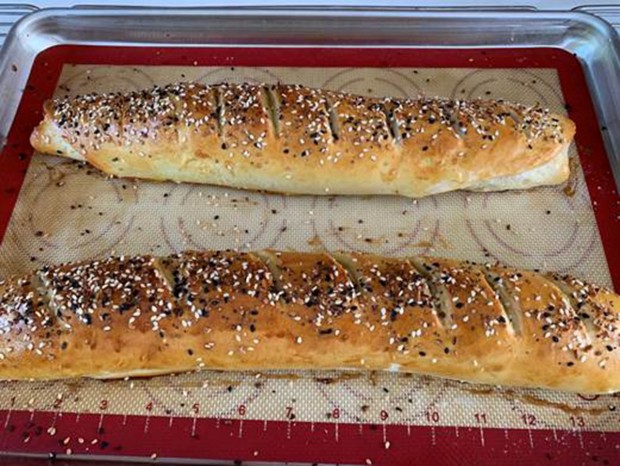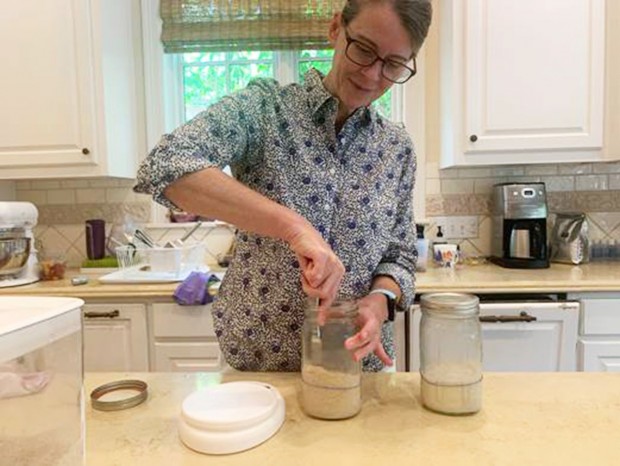Bread Baking on the Rise across Houston

Buzz summer intern Julia Smith dives into the trend of bread-baking during the pandemic.
West University mom Suanne Bouvier learned how to do two things during quarantine: sew masks for a group called Masks of Hope and bake bread. Though the activities may seem unrelated, Bouvier’s active mind and sense of community quickly brought them together.
Every Wednesday afternoon, she takes her baguettes (recipe here), topped with everything bagel seasoning, out of the oven.
“As soon as [the bread] came out, I would put it outside and cover it with a cloth,” Bouvier said. “[My friends] would come by with a baking sheet and their tongs, and so we would have no contact at all.”
Some friends picking up bread would leave fabric for masks in its place, thus not only bringing together Bouvier’s newfound talents, but connecting the community as well.
“It takes a whole village to get through being sheltered at home,” she said. “And bread is so comforting.”
The comfort of bread-baking has become more and more popular across the U.S. as quarantine continues. While some, like Bouvier, have made no-knead bread and baguettes, many have taken on the challenge of sourdough.
Mother-of-two Ashley Klaasmeyer has become a regular baker of sourdough as the pandemic continues. Until quarantine, she had not baked bread for around 10 years, but decided to begin to experiment with different types while stuck at home.
She has made white and wheat sandwich bread, a country loaf, and two different types of sourdough.
Sourdough bread is tricky, but a big hit in the Klaasmeyer household. The bread is made from a starter that contains active dry yeast, flour, and warm water. Over the course of a few weeks, bakers must remove excess growth and “feed” the dough with water and flour. The sourdough starter, which she feeds twice a week to continue its growth, has been lovingly named Crash.
“That was a combination of my husband Craig and my name, Ashley,” Klaasmeyer said. “Because we’re both responsible for feeding it.”
Naming sourdough starter has become common. In our house, my mom, Cristina Smith, refers to hers as Rosalita and Moses, and neighbor Pamela Laborde has taken to calling hers Joe, which means “God will increase,” a perfect name for the rising dough.
My mom started trying to grow sourdough a few months ago, as a quarantine hobby. She had thought about it for a while but decided to take the plunge while stuck at home due to the coronavirus. She referred to this site to get started.
She made two different sourdough starters as an experiment, one with white flour and the other with whole wheat flour.
“It’s just interesting to see how they differ. The whole wheat flour is way more active,” she said. “It’s always risen a lot more. But in the end, I don’t think the starters act differently when making bread.”
She has baked bread twice so far but has used discard from the starter in creative and inventive ways several times; she used this website for inspiration. Using recipes from friends and online, our family has made chocolate cake, banana bread, pancakes, and crackers.
She received the sourdough cracker recipe from Laborde, who has grown starter as well.
“It’s the perfect recipe for me, because it’s discard, a tiny bit of butter, any seasonings you want to put in it, and that’s it,” Laborde said. “You get this amazing, sourdough flavor, crisp cracker.”
Klaasmeyer also has used discard recipes. She enjoys baking “sourdough breakfasts” for her family, including pancakes and waffles made with the excess starter.
The process of baking bread, however, is not only a creative and fun activity. It brings peace to many households during the stress of the pandemic by connecting neighbors and providing a form of relaxation.
My mom and Laborde regularly text back and forth about their starters, troubleshooting and sharing various recipes.
“I haven’t been talking to a lot of people,” Laborde said. “It makes me feel good to text [Smith] and get a happy reply back.”
For my mom, she enjoys having something simple and relaxing to chat about with friends that isn’t related to the stressful topics that surround her regularly, including politics and the coronavirus.
“It’s a nice, peaceful conversation that is non-controversial, no matter who you’re talking to,” she said.
The process, for many, is also incredibly relaxing. Bouvier refers to her weekly baking ritual as a form of relaxation.
“I think [my favorite thing] is the smell of fresh bread that just permeates through your entire house,” she said. “It’s so comforting.”
Working with the sourdough starter is a peaceful and stress-free activity for Laborde, providing a sense of normalcy in the midst of Covid-19.
“I like to watch it bubble and rise when it’s sitting on my counter,” Laborde said. “I love the process of it being healthy and growing and knowing that I’m keeping that alive.”
Baking bread, whether baguettes or sourdough, has connected members of the community to one another and provided a much-needed opportunity for relaxation throughout this difficult time.
“It’s something that is very grounding,” Laborde said. “It brings a sense of normalcy to our world, connects you to your home, family, and friends.”
Editor's note: For more on baking during the pandemic, see related stories about chocolate chip cookies, coronavirus-themed cakes and banana bread. Also, see Andria Frankfort's weekly Back Porch Table column for recipe inspiration.
Want more buzz like this? Sign up for our Morning Buzz emails.
To leave a comment, please log in or create an account with The Buzz Magazines, Disqus, Facebook, or Twitter. Or you may post as a guest.




